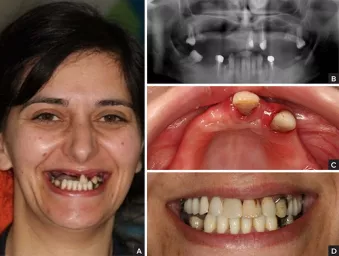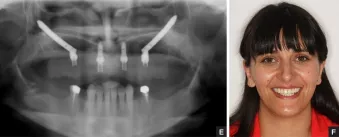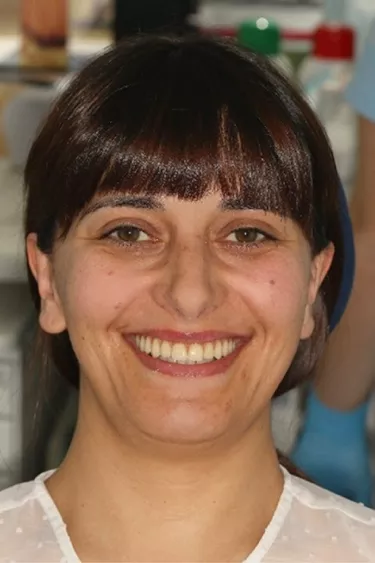
Successful 10-year outcomes of NobelProcera® restoration in hybrid All-on-4® treatment concept
Clinical situation
A 34-year-old healthy female patient visited Malo Clinic Lisbon in October 2012 with the goal of having fixed teeth in the maxilla. She had been using an upper removable denture for more than 15 years and was uncomfortable and unhappy with this situation. She found the clinic through Portuguese media and television programs. After clinical and radiographic examination, atrophic maxilla with failing dentition was diagnosed.

A. Initial extraoral photo without dentures, in a maximum smile, B. Orthopantomogram, C. Initial intraoral maxilla occlusal view, D. extraoral photo with denture at maximum smile.
Treatment plan and surgical procedure
Cone beam computed tomography (CBCT) scans showed bone volume of less than 5 mm width by 10 mm height between the inter canine area. Due to extensive alveolar bone resorption, the standard All-on-4® treatment concept was not ideal. To avoid long and extensive bone augmentation procedures, we decided to use hybrid All-on-4® rehabilitation.
The surgery was performed in March 2013. After extracting the hopeless teeth and raising the flap, two NobelSpeedy Groovy NP 3.3 x 10 mm implants were placed in the anterior region of the maxilla (in the 12 and 22 positions). Two NobelZygoma 0˚ 5.0 x 40 mm implants were placed in the zygomatic bone (in the 15 and 25 positions) following the extramaxilla technique.1 All the implants reached 50 Ncm torque and two straight Multi-unit Abutments of 2 mm were tightened to 30 Ncm at the anterior implants. One 45˚ Multi-unit Abutment of 6 mm and one 45˚ Multi-unit Abutment of 8 mm were tightened to 30 Ncm each at the NobelZygoma implants. Five hours after surgery, the patient received a fixed screw-retained all-acrylic provisional 12-unit bridge crowns.

E Post-operative orthopantomogram, F Patient smile with provisional bridge two months post-op.
Final bridge
The final prosthetic procedure started four months after surgery. A definitive impression was taken in two steps: first, multi-unit impression copings and stainless-steel bars were splinted together with a low-contraction autopolymerizing acrylic resin, and second, a definitive impression was made with a custom open tray and addition reaction silicone impression material.
The dental laboratory used the tooth arrangement on the fixed screw-retained all-acrylic provisional bridge as a starting point to manufacture the definitive prosthesis. First, an acrylic resin screw-retained pattern of the provisional bridge was made on the master cast to plan the future titanium framework. This acrylic resin pattern was fabricated with 12 individual crown preparations to accommodate the corresponding individual ceramic crowns. After the pattern was completed, it was scanned and uploaded to the NobelProcera® software. The data were transferred digitally to a milling machine for the fabrication of a NobelProcera titanium framework.

G. Maxilla definitive impression preparation with multi-unit impression copings splinted with stainless-steel bars, H. NobelProcera titanium framework.
Once the titanium framework was milled, a silicone impression was made of the framework preparations. Twelve monolithic ceramic crowns were then fabricated and milled in lithium disilicate. After glazing, the crowns were cemented to the framework using a definitive cement, the screw access openings were opened, and the customized acrylic gingiva was applied and polymerized around the crowns and in the inferior portion of the prosthesis.2

I. NobelProcera titanium framework silicone impression, J. NobelProcera titanium framework with the ceramic crowns cemented.
The final bridge was delivered six months after surgery and the patient was enrolled in our clinic maintenance program, which includes regular semi-annual oral hygiene appointments and peri-implant soft tissue health and implant condition assessment.

K. 10-year follow-up; occlusal view, L. Frontal view. M Orthopantomogram.
References
1. Maló P, Nobre Mde A, Lopes I. A new approach to rehabilitate the severely atrophic maxilla using extramaxillary anchored implants in immediate function: a pilot study. J Prosthet Dent. 2008 Nov;100(5):354-66.
Read on Pubmed
2. Maló P, de Araújo Nobre M, Borges J, Almeida R. Retrievable metal ceramic implant-supported fixed prostheses with milled titanium frameworks and all-ceramic crowns: retrospective clinical study with up to 10 years of follow-up. J Prosthodont. 2012 Jun;21(4):256-64.
Read on Pubmed
